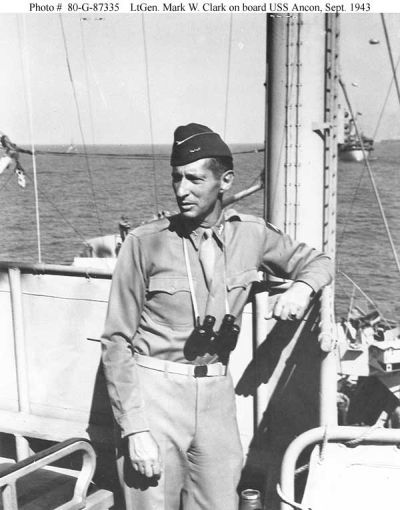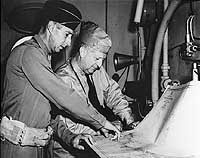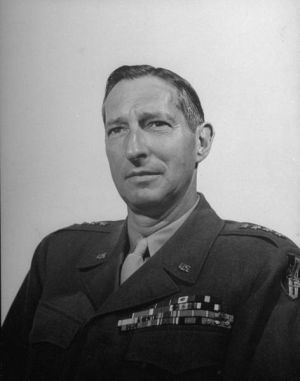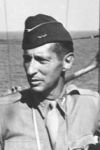Introduction
Over a period of 24 years Mark Wayne Clark (1896 – 1984) made a lightning career in the American army, ending up as general. On his promotion to Lieutenant-general in 1942, he was the youngest three star general ever in the American army. In a biography, published by the U.S. Army, it is suggested Clark partly owed this to his professional relationship with General George Marshall and his friendship with General Dwight D. Eisenhower (Bio Eisenhower). Eisenhower however argues Clark owes this to his phenomenal capabilities.
Pre war period
Mark Wayne Clark was born May 1, 1896 in New York. He spent the major part of his youth in Illinois as his father, Charles Carr Clark, an infantry officer, was based in Fort Sheridan. Clark’s mother was a housewife. Clark embarked on his military career at the well known military academy of West Point. He was admitted to this four year course as early as June 1913 at the age of 17. During his tenure at West Point, he suffered from various diseases but he graduated in 1917. At the academy he befriended the later general Dwight Eisenhower. At Clark’s graduation, World War One was raging in full. He saw action himself in the French Vosges where he was injured in battle. During his recuperation he was transferred to Headquarters First United States Army and saw no more action at the front during the remainder of the war.
World War Two
In the interbellum, Clark held several functions within the American army and was promoted a few times. In this period he rose from Captain to Lieutenant-colonel and he mainly served as a military instructor. On August 4, 1941, a few months prior to America’s entry into the war, he was promoted to Brigadier-general. In August and September, large military maneuvers took place in Louisiana, hence the name Louisiana Maneuvers. Some 400.000 soldiers took part in these exercises, spread over 19 divisions. The immense training ground of no less than 3,398 square miles of barren country was selected by General Leslie McNair and Clark himself. Eisenhower stated later his old friendship with Clark had been rekindled by these exercises. About Clark’s capabilities, Eisenhower wrote: "He and I worked closely together continuously during the various stages of these field exercises we both enjoyed so much. I gained a lasting respect for his abilities as designer of plans, as leader of maneuvers and as organizer which I have never seen surpassed by any other officer."
When Eisenhower was ordered by General Marshall in the spring of 1942 to investigate the possibilities for the future organization of the American forces in Great Britain, he asked permission to take Clark with him and his request was granted. Clark left for Great Britain in June 1942. In the subsequent months he would hold various functions such as commander of II Corps to which he had been appointed in July. Less than a month later he moved on to the post of Commander General American Forces European Theatre and on August 17 he was promoted to Major-general. It took until October of that year before he was given a new function: deputy Commander Allied Forces North-Africa. Clark’s duties entailed planning and training the Allied forces for Operation Torch. Eisenhower was satisfied with having appointed Clark his deputy. "He was rather young but a highly capable career officer with a gift for choosing eminent subordinates and for raising the morale of his staff to a high level. […] More than anyone else, Clark was instrumental in the efficient coordination of the various elements in this first Allied plan for an amphibious attack by the Allies in the Mediterranean." It shows Eisenhower had full confidence in Clark’s capabilities. Part of the preparations for this operation entailed negotiations with Vichy-France. These talks were necessary as Vichy-French troops were stationed in Morocco. A few weeks prior to the start of the operation, Clark went to Cherchell in Algeria by submarine in order to negotiate. Eisenhower selected him personally to take part in this mission. These talks took place on October 21 and 22, 1942. During this mission, Vichy-France promised to cooperate with the Allies. Following these negotiations, Clark was promoted to Lieutenant-general on November 11, 1942.
On January 4, 1943, the first American army was formed overseas. This army was called the Fifth United States Army and Clark was placed in charge. His main duty was to prepare the American troops for Operation Avalanche, the Salerno landings which took place on September 9, 1943. The German troops resisted fiercely. A few days after the landing, on September 13, German resistance was unleashed in full force. The Germans put so much pressure on the center of the Allied bridgehead, there was a real chance the combined forces would be split in two. This necessitated Clark to draft a temporary plan to establish his headquarters back at sea and to direct his troops from elsewhere. It did not go that far though. It is remarkable the British blamed Clark for his poor leadership while Eisenhower states: "He proved himself a fine leader in battle; he fully confirmed the personal confidence which had caused me to put him in such an important position." Although there are no direct connections between these events, it is remarkable that a few days later, Eisenhower fired one of his corps commanders at Clark’s request. Reluctantly, Eisenhower granted his request.
There are a few controversies about Clark’s conduct during World War Two. On February 15, during the battle for Monte Cassino, Clark ordered a bombardment of the abbey. The order issued by Clark was based on an order by a superior. In the opinion of some, this makes Clark responsible for this bombardment. In reality, Clark and his chief of staff Alfred Gruenther expressed their doubts about the strategic value of bombarding Monte Cassino. Clark did pressure his superior, General Harold Alexander: "You have given me a direct order and we will execute it."
On June 4, 1944 Rome was captured by the U.S. VI Corps. This was Clark’s best known achievement in World War Two. In order to capture Rome, he ignored an order by General Alexander and as a consequence, he failed to close the gap in the German lines that appeared after the seizure of Monte Cassino. A sizable number of German units managed to escape through this gap to eventually strengthen the defense of the Gothic line. Clark was thanked by Pope Pius XII personally for the capture of Rome.
In December 1944, Clark replaced General Alexander as commander of 15th Army Group. From that moment on, he was in command of all Allied ground forces in Italy. On March 10, 1945, Clark was promoted to general. Towards the end of the war, Clark was in command of all Allied forces in Italy and in a later stage U.S. High Commissioner in Austria.
After the war
After World War Two, Clark served in various functions in the American army. He returned to the United States in January 1947 and was given command of 6th Army. A little over two years later he was named Commander-in-Chief of all American ground forces. On May 12, 1952, during the Korean war, Clark succeeded Matthew Ridgeway as commander of the forces of the United Nations. In this capacity, Clark signed a cease-fire agreement with North Korea in 1953, an agreement that is still in force today.
After his discharge, Clark was appointed president of the Citadel, a military college in South Carolina. He held this function from 1954 to 1966. During this period, he also wrote his memoirs.
Mark Wayne Clark passed away on April 17, 1984 at the age of 87.
Definitielijst
- infantry
- Foot soldiers of a given army.
- interbellum
- “Latin: Between war”. Years between the Great War and World War 2.
- resistance
- Resistance against the enemy. Often also with armed resources.
Images
Information
- Translated by:
- Arnold Palthe
- Published on:
- 17-05-2017
- Last edit on:
- 03-11-2023
- Feedback?
- Send it!











